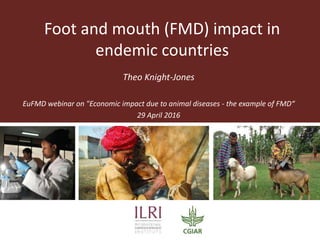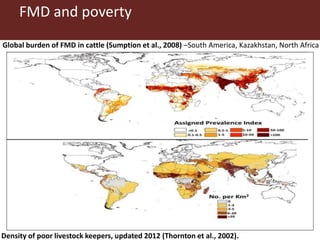Foot and mouth disease (FMD) impact in endemic countries
- 1. Theo Knight-Jones EuFMD webinar on "Economic impact due to animal diseases - the example of FMD“ 29 April 2016 Foot and mouth (FMD) impact in endemic countries
- 2. Key Questions • How important is FMD in endemic countries? • How does it impact? • How can we measure this?
- 3. FMD and poverty Global burden of FMD in cattle (Sumption et al., 2008) –South America, Kazakhstan, North Africa Density of poor livestock keepers, updated 2012 (Thornton et al., 2002).
- 4. OIE 2015 FMD status • Few places where FMD is not present in poor livestock keeper populations - Central and South America, Kazakhstan and Southern Africa, parts of South East Asia. • FMD endemicity associated with poverty – Why? • Governance (regional, national, local), FMD status of neighbours • Cost of control relative to wealth, shared grazing, civil unrest • Equates within country – see Turkey, Southern Africa
- 5. 5 Robinson et al., 2011. Global livestock production systems. FAO and ILRI Free versus endemic Endemic FMD impact = Free-country FMD risk Endemic countries contain 75% of global human population and FMD-susceptible species population • FMD risk is a product of cross-border disparity • Wealth, development & disease status Density of rural poor livestock keepers/KM2
- 6. What is FMD burden in endemic countries? • Globally US$6.5 -21 billion/year direct and vaccination costs only (Knight-Jones & Rushton, 2013) • But US$2.7–3.6 billion/year in India alone (Ganesh Kumar, 2012) • Impact in endemic countries is uncertain and neglected? • Limited evidence creates space for subjective, often non-representative opinion • What simple, objective evidence is there?
- 7. FMD Sero-prevalence studies (McLaws et al., 2014) Approx. 30% cattle infected per year - % with clinical disease?
- 8. Question • Direct impact relates to clinical disease • On average what percentage of FMDV infected cattle develop clinical FMD? • Answer options: 25%, 50%, 75%, 100%
- 9. FMD Sero-prevalence studies (McLaws et al., 2014) Approx. 30% cattle infected per year - % with clinical disease? But within a country incidence is highly variable
- 10. How are endemic countries affected? Ongoing or sporadic impacts – Often difficult to measure ? May be other trade barriers: Disease, reliable meat quality, competition Modified from Rushton et al. 1999
- 11. Measuring impacts Impacts Significance Gaps Invisible production losses Reduced fertility Significance –High Knowledge – Limited Ease of estimation - Moderate As a long term impact this has not been captured but could be modelled Changes in herd structure Significance –Variable Knowledge – Limited Ease of estimation – Difficult As a consequence of reduced fertility more adults will be maintained per unit of outputs (milk, cattle for meat) leading to an overall need for greater inputs per unit of output Delay in the sale of animals and products Significance –Variable Knowledge – Limited Ease of estimation – Difficult Timing of sales may be suboptimal as a consequence of reduced weight gains or salvaging cull animals Knight-Jones, T. J. D., McLaws, M. and J. Rushton, 2016: Foot-and-mouth disease impact on smallholders - What do we know, what don’t we know and how can we find out more? Transbound Emerg Dis, In press.
- 12. Brazil - FMD outbreaks and vaccination. Naranjo & Cosivi, Proc Roy Soc B, 2013 South America – Export of meat from FMD-susceptible species FMD and exports – South America
- 13. Question • Which country exported the largest volume of beef in the world in 2014?
- 14. Question • Which country exported the largest volume of beef in the world in 2014? • Answer: India – so FMD free status not always needed for thriving exports (although trade has since been affected by FMD)
- 15. Cost of control • Impact of wildlife control • Fencing and zonation restricts movement of wildlife and people • FMD freedom may be fragile – especially near African Buffalo populations • Commodity based trade – a sustainable alternative? • Vaccination is expensive $1 per dose >2 billion doses per year worldwide • Requires ongoing programme (Europe & S. America – took decades)
- 16. France - FMD outbreaks and vaccination. Lombard et al, OIE, Rev. sci. tech., 2007. The Netherlands - FMD outbreaks and vaccination. Dekker, A. Foot- and-mouth disease vaccine induced protection. (2010).
- 17. Vaccination & control • Need quality assured vaccine, effective against local strains “The most expensive medicine is the one that doesn’t work” • Many poor livestock keepers depend on communal grazing & frequent trading • Livestock are bankable assets sold when cash needed • Producers motivated by herd-size not productivity & FMD does not kill (much) • Movement restrictions unpopular and hard to enforce • Culling not feasible (too many cases & cost) • Can FMD be controlled by vaccination alone if movement controls are ineffective? • Economic analyses in endemic countries often use unsubstantiated, optimistic vaccination effect
- 18. How to measure? • Mixture of: • Retrospective ex post studies • Field impact studies (before vs. after, or trials) • Modelling studies • Need to capture: • Herd & household, sector impacts, wider economy • Household impact as % of annual income • Consider both affected and population level impact • Trade effects – Important but difficult to capture • Food security – difficult to capture – important if dependent on milk
- 19. Conclusion • Impact is high where incidence is high, for those dependent on commodities whose production and trade is sensitive to FMD • Most visible for milk & pigs & trade bans • Some producers may be relatively unaffected or resilient to FMD • But may be one of many barriers to development • improved breeds, market access
- 20. Conclusion • National impact again depends on incidence and economic susceptibility to FMD • Burden to individual households may be variable but with high prevalence, population level burden may still be large • Hence cannot leave control to individuals • Effective control needs central & regional coordination
- 21. Key Questions • How important is FMD in endemic countries? • How does it impact? • How can we measure this? • Current knowledge is too patchy & theoretical • More data needed
- 22. Examples – No comprehensive analysis Jemberu, W. T., M. C. Mourits, T. Woldehanna and H. Hogeveen, 2014: Economic impact of foot and mouth disease outbreaks on smallholder farmers in Ethiopia. Prev Vet Med, 116, 26-36. Young, J. R., S. Suon, C. J. Andrews, L. A. Henry and P. A. Windsor, 2013: Assessment of financial impact of foot and mouth disease on smallholder cattle farmers in Southern Cambodia. Transbound Emerg Dis, 60, 166-174. Young, J. R., S. Suon, L. Rast, S. Nampanya, P. A. Windsor and R. D. Bush, 2014: Benefit-cost analysis of foot and mouth disease control in large ruminants in Cambodia. Transbound Emerg Dis. Nampanya, S., S. Khounsy, R. Abila, J. R. Young, R. D. Bush and P. A. Windsor, 2015a: Financial Impacts of Foot-and-Mouth Disease at Village and National Levels in Lao PDR. Transbound Emerg Dis. Nampanya, S., S. Khounsy, A. Phonvisay, J. R. Young, R. D. Bush and P. A. Windsor, 2015b: Financial Impact of Foot and Mouth Disease on Large Ruminant Smallholder Farmers in the Greater Mekong Subregion. Transbound Emerg Dis, 62, 555-564. Casey, M. B., S. Cleaveland, D. Mshanga, T. Kibona, H. Auty, T. Marsh, J. Yoder, B. Perry, R. Kazwala, D. Haydon, D. King, S. Parida, D. J. Paton, R. Reeve and T. Lembo, 2014: Household level impacts of FMD on traditional livestock keeping systems of Northern Tanzania, Oral presentation EuFMD Open Session, Cavtat, Croatia, 29-31 Oct 2014. Shankar, B., S. Morzaria, A. Fiorucci and M. Hak, 2012: Animal disease and livestock-keeper livelihoods in Southern Cambodia. International Development Planning Review, 34, 39-63. Garabed R.B., Johnson W.O., Gill J., Perez A.M. & Thurmond M.C. (2008). – Exploration of associations between governance and economics and country level foot-and-mouth disease status by using Bayesian model averaging. J Roy Stat Soc A, 171 (3), 699-722.
- 23. The presentation has a Creative Commons licence. You are free to re-use or distribute this work, provided credit is given to ILRI. better lives through livestock ilri.org Dr Theo Knight-Jones [email protected]























